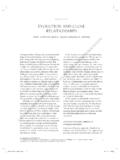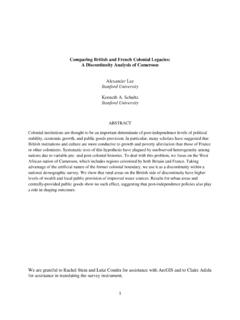Transcription of What have we learned about the causes of corruption from ...
1 What have we learned about the causes of corruption from ten years of crossnational empirical research? I review recent efforts by political scientists and economists to explain crossnational variation in corruption using subjective ratings, and examine the robustness of reported findings. Quite strong evidence suggests that highly developed, long-established liberal democracies, with a free and widely read press, a high share of women in government, and a history of openness to trade are perceived as less corrupt. Countries that depend on fuel exports or have intrusive business regulations and unpredictable inflation are judged more corrupt. While the causal direction is usually unclear, instrumenting with income as of 1700 suggests higher development does cause lower perceived corruption . However, controlling for income, most factors that predict perceived corruption do not correlate with recently available measures of actual corruption experiences (based on surveys of businessmen and citizens that ask whether they have been expected to pay bribes recently).
2 Reported corruption experiences correlate with lower development, and possibly with dependence on fuel exports, lower trade openness, and more intrusive regulations. The subjective data may reflect opinion rather than experience, and future research could usefully focus on experience-based indicators. Daniel Treisman Department of Political Science, University of California, Los Angeles, 4289 Bunche Hall Los Angeles, CA 90095 Tel: 310 968 3274 November 2006 I am grateful to Johann Graf Lambsdorff for comments. Key Words: governance, bribery, democracy, Introduction In recent years, a growing community of political scientists and economists has sought to understand why in some countries governments and the bureaucrats they control are more corrupt than in others. corruption is usually understood to mean the misuse of public office for private gain, where the private gain may accrue either to the individual official or to groups or parties to which he belongs.
3 The quintessential corrupt transaction envisioned is the gift of a bribe by a private citizen to a public official in return for some service that the official should either provide for free ( registering a firm) or not provide at all ( inside information). Scholars like novelists, businessmen, and other global travellers have long taken it as given that such exchanges occur more frequently in some countries, such as Indonesia or Nigeria, than in others, such as Canada or Iceland. about a decade ago, attempts to measure and explain such differences received a dramatic boost from two events. First, the Berlin-based organization Transparency International, which campaigns for honest government, began constructing a summary index of countries perceived corruption in the hope of embarrassing their leaders into reform. Second, around the same time an economist, Paolo Mauro, published an article that, using a similar cross-national rating of corruption compiled by a business consultancy, reported evidence of a long-suspected link between higher corruption and slower economic growth (Mauro 1995).
4 Soon others were using such data to investigate what factors explained why some countries governments were perceived to be more corrupt than In this article, I survey the first decade or so of such work. There is already too much to cover comprehensively within the space limits; Lambsdorff (2005) is a useful review. Instead, I 1 For early examples, see Ades and Di Tella (1997), La Porta et al. (1999), and Treisman (2000). The growing attraction of corruption studies can be gauged from a quick search of the article database JSTOR. Searching its political science and economics journals for the word corruption resulted in 1,945 hits from the 1970s; 2,277 from the 1980s; and 3,278 from the 1990s. Searching for uses of corruption and statistics in the same text yielded 419 cases from the 1970s; 481 from the 1980s; and 779 from the 1990s. 2 focus on a few key questions about the reliability of the data, methods of analysis, and the robustness of certain results.
5 Where possible, I use the data themselves to try to resolve open issues. The goal is to provide a guide to readers of this literature that do not have the relevant data on their hard drive, and to sum up what is known and what is not at the end of this first phase of data exploration . Of course, there are various paths one could follow through this body of work, and different scholars might draw different conclusions on key points. I encourage interested readers to take their own look at the data, which will be posted on my website at Examination of these data reveals a puzzling dichotomy. The more subjective indexes of perceived corruption based on evaluations of experts and opinions of businessmen and citizens turn out to be highly correlated with a variety of factors that are commonly believed to cause corruption . Perceived corruption , as measured by such indexes, is lower in economically developed, long-established liberal democracies, with a free and widely read press, a high share of women in government and a history of openness to trade.
6 It is higher in countries that depend on fuel exports or have intrusive business regulations and unpredictable inflation. These factors explain up to 90 percent of the crossnational variation. However, measures of actual corruption experiences (based on surveys that ask businessmen and citizens in different countries whether they have been expected to pay bribes recently) correlate with hardly any of these factors once one controls for income. Reported experience with corruption correlates with lower development, and possibly with dependence on fuel exports, lower trade exposure, and more intrusive regulations. It is possible that the experience-based measures are noisier and less reliable or are measuring a different phenomenon (petty as opposed to grand corruption , perhaps). But it could also be that the widely-used subjective indexes are capturing not observations of the frequency of corruption but inferences made by experts and survey respondents on the basis of conventional understandings of corruption s causes .
7 I conclude that the challenge of the next wave of research 3 will be to refine and gather more experience-based measures of corruption and to examine the patterns they reveal. 2 The new data Main sources Two indexes of perceived corruption have become the most commonly used in empirical work the corruption Perceptions Index (CPI) constructed by Transparency International (TI) and a rating of control of corruption published by a team led by Daniel Kaufmann at the World Bank (WB). (Details are available at and ) Both of these aggregate information from a number of sources that include country risk ratings produced by business consultancies, surveys of international or domestic business people, and polls of country inhabitants. Both groups aim to reduce measurement error by averaging different sources, and use similar (and overlapping ) sets of inputs. Their methods for constructing indexes differ in two main regards.
8 TI essentially averages the standardized values, while adjusting to reduce the sensitivity of the index to changes in the surveys and countries included. The WB team treats the individual ratings as noisy measures of a common latent variable, and estimates this using an unobserved components model (see, , Kaufmann, Kraay, and Mastruzzi 2006). While the WB team includes all countries for which one component rating is available, TI only includes countries for which three ratings are available, which probably increases precision but leads to narrower country coverage. TI has calculated ratings annually since 1995. The WB group produced its indexes bi-annually from 1996 to 2002, but now publishes new versions yearly. Coverage has increased over time from 54 countries in 1996 to 159 in 2005 for TI, and from 152 to 204 for the WB group during the same period. Despite the different methodologies and sometimes different sources, the two ratings are extremely highly correlated.
9 In the years for which both have been available, the 4 correlation has varied between r = .96 in 2002 and r = .98 in 2004. Both groups also publish the number of sources on which each country s rating is based and estimates of the precision of each country s rating. In TI s case, these standard errors are (since 2001) calculated by a bootstrap methodology. In 2005 the standard error was just .15 for Liberia, suggesting a great deal of agreement about the country s corruption level, but for Laos, suggesting far more disagreement. WB publishes standard errors from its unobserved components estimation, which decrease with the number of sources available for the given country and with the extent to which these sources correlate with other sources across all countries. Although the TI and WB perceived corruption indexes are the most frequently used, a number of studies have analyzed a third crossnational corruption rating produced by the firm Political Risk Services (PRS), based on evaluations by its network of experts, and published in its International Country Risk Guide (ICRG).
10 Unlike the TI and WB data, these are only available for purchase. The main attraction of the ICRG data is that ratings are available for all years since the early 1980s, which has tempted some to use them for cross section time series analyses. The ICRG data have been used in the construction of the WB index, and not surprisingly they are highly correlated with both TI and WB (the latest ICRG data I had were for 1995; these correlated at r = .88 with the 1996 TI index and at r = .84 with the 1996 WB rating). All three of these are based on the subjective evaluations of experts or survey respondents of how widespread or costly corruption is in particular countries. More recently, certain other surveys have asked respondents about their own (or their family s or firm s) experience. In 2004 and 2005, TI conducted a Global corruption Barometer (GCB) survey of inhabitants of 64 and 69 countries respectively, and asked in one question whether the respondent or anyone in his or her household had paid a bribe in any form during the previous 12 months.








